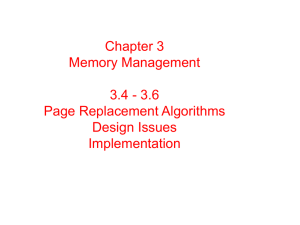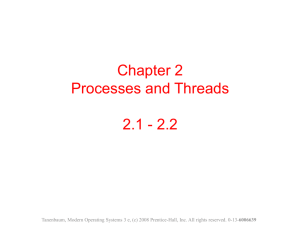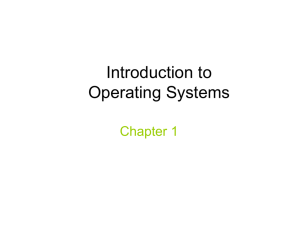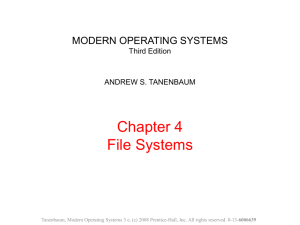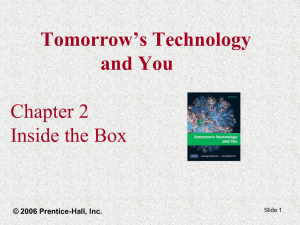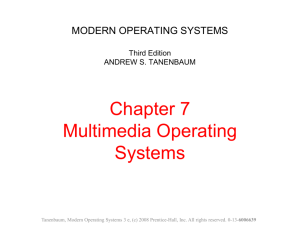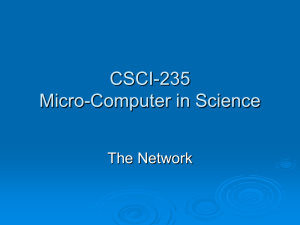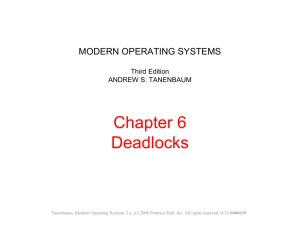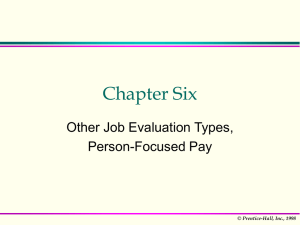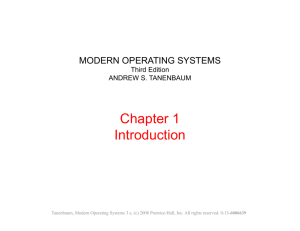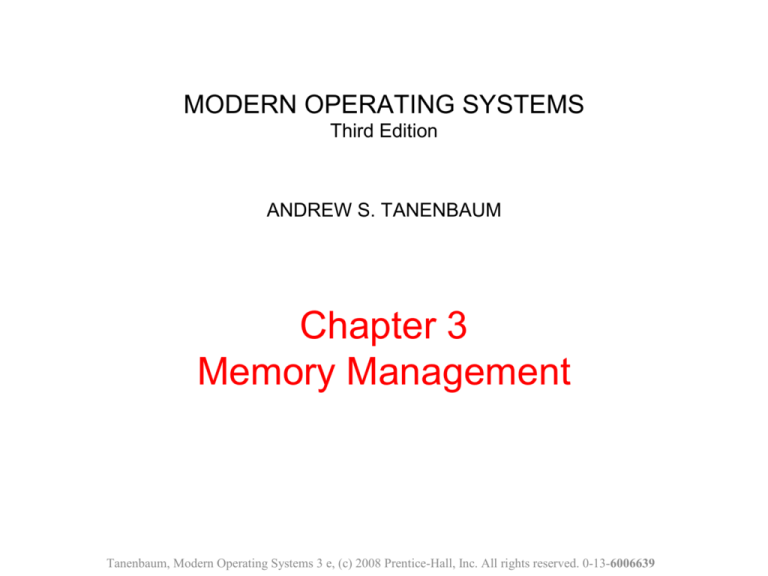
MODERN OPERATING SYSTEMS
Third Edition
ANDREW S. TANENBAUM
Chapter 3
Memory Management
Tanenbaum, Modern Operating Systems 3 e, (c) 2008 Prentice-Hall, Inc. All rights reserved. 0-13-6006639
No Memory Abstraction
Figure 3-1. Three simple ways of organizing memory with an
operating system and one user process.
Tanenbaum, Modern Operating Systems 3 e, (c) 2008 Prentice-Hall, Inc. All rights reserved. 0-13-6006639
Multiple Programs Without Memory
Abstraction
Figure 3-2. Illustration of the relocation problem.
Tanenbaum, Modern Operating Systems 3 e, (c) 2008 Prentice-Hall, Inc. All rights reserved. 0-13-6006639
Base and Limit Registers
Figure 3-3. Base and limit registers can be used to give each
process a separate address space.
Tanenbaum, Modern Operating Systems 3 e, (c) 2008 Prentice-Hall, Inc. All rights reserved. 0-13-6006639
Swapping (1)
Figure 3-4. Memory allocation changes as processes come into
memory and leave it. The shaded regions are unused memory.
Tanenbaum, Modern Operating Systems 3 e, (c) 2008 Prentice-Hall, Inc. All rights reserved. 0-13-6006639
Swapping (2)
Figure 3-5. (a) Allocating space for growing data segment. (b)
Allocating space for growing stack, growing data segment.
Tanenbaum, Modern Operating Systems 3 e, (c) 2008 Prentice-Hall, Inc. All rights reserved. 0-13-6006639
Virtual Memory – Paging (1)
Figure 3-8. The position and function of the MMU – shown as
being a part of the CPU chip (it commonly is nowadays).
Logically it could be a separate chip, was in years gone by.
Tanenbaum, Modern Operating Systems 3 e, (c) 2008 Prentice-Hall, Inc. All rights reserved. 0-13-6006639
Paging (2)
Figure 3-9. Relation between virtual addresses and
physical memory addresses given by page table.
Tanenbaum, Modern Operating Systems 3 e, (c) 2008 Prentice-Hall, Inc. All rights reserved. 0-13-6006639
Paging (3)
Figure 3-10. The internal operation of the MMU with
16 4-KB pages.
Tanenbaum, Modern Operating Systems 3 e, (c) 2008 Prentice-Hall, Inc. All rights reserved. 0-13-6006639
Structure of Page Table Entry
Figure 3-11. A typical page table entry.
Tanenbaum, Modern Operating Systems 3 e, (c) 2008 Prentice-Hall, Inc. All rights reserved. 0-13-6006639
Speeding Up Paging
Paging implementation issues:
•
•
The mapping from virtual address to physical
address must be fast.
If the virtual address space is large, the page table
will be large.
Tanenbaum, Modern Operating Systems 3 e, (c) 2008 Prentice-Hall, Inc. All rights reserved. 0-13-6006639
Translation Lookaside Buffers
Figure 3-12. A TLB to speed up paging.
Tanenbaum, Modern Operating Systems 3 e, (c) 2008 Prentice-Hall, Inc. All rights reserved. 0-13-6006639
Multilevel Page Tables
Figure 3-13. (a) A 32-bit address with two page table fields.
(b) Two-level page tables.
Tanenbaum, Modern Operating Systems 3 e, (c) 2008 Prentice-Hall, Inc. All rights reserved. 0-13-6006639
Page Replacement Algorithms
•
•
•
•
•
•
•
•
Optimal page replacement algorithm
Not recently used page replacement
First-In, First-Out page replacement
Second chance page replacement
Clock page replacement
Least recently used page replacement
Working set page replacement
WSClock page replacement
Tanenbaum, Modern Operating Systems 3 e, (c) 2008 Prentice-Hall, Inc. All rights reserved. 0-13-6006639
The Clock Page Replacement
Algorithm
Figure 3-16. The clock page replacement algorithm.
Tanenbaum, Modern Operating Systems 3 e, (c) 2008 Prentice-Hall, Inc. All rights reserved. 0-13-6006639
Working Set Page Replacement (1)
Figure 3-19. The working set is the set of pages used by the k
most recent memory references. The function w(k, t) is the
size of the working set at time t.
Tanenbaum, Modern Operating Systems 3 e, (c) 2008 Prentice-Hall, Inc. All rights reserved. 0-13-6006639
Summary of Page Replacement Algorithms
Figure 3-22. Page replacement algorithms discussed in the text.
Tanenbaum, Modern Operating Systems 3 e, (c) 2008 Prentice-Hall, Inc. All rights reserved. 0-13-6006639
Separate Instruction and Data Spaces
Figure 3-25. (a) One address space.
(b) Separate I and D spaces.
Tanenbaum, Modern Operating Systems 3 e, (c) 2008 Prentice-Hall, Inc. All rights reserved. 0-13-6006639
Shared Pages
Figure 3-26. Two processes sharing the same program
sharing its page table.
Tanenbaum, Modern Operating Systems 3 e, (c) 2008 Prentice-Hall, Inc. All rights reserved. 0-13-6006639
Shared Libraries
Figure 3-27. A shared library being used by two processes.
Tanenbaum, Modern Operating Systems 3 e, (c) 2008 Prentice-Hall, Inc. All rights reserved. 0-13-6006639
Page Fault Handling (1)
•
•
•
•
The hardware traps to the kernel, saving the
program counter on the stack.
An assembly code routine is started to save the
general registers and other volatile information.
The operating system discovers that a page
fault has occurred, and tries to discover which
virtual page is needed.
Once the virtual address that caused the fault is
known, the system checks to see if this address
is valid and the protection consistent with the
access
Tanenbaum, Modern Operating Systems 3 e, (c) 2008 Prentice-Hall, Inc. All rights reserved. 0-13-6006639
Page Fault Handling (2)
•
•
•
If the page frame selected is dirty, the page is
scheduled for transfer to the disk, and a context
switch takes place.
When page frame is clean, operating system
looks up the disk address where the needed
page is, schedules a disk operation to bring it in.
When disk interrupt indicates page has arrived,
page tables updated to reflect position, frame
marked as being in normal state.
Tanenbaum, Modern Operating Systems 3 e, (c) 2008 Prentice-Hall, Inc. All rights reserved. 0-13-6006639
Page Fault Handling (3)
•
•
•
Faulting instruction backed up to state it had
when it began and program counter reset to
point to that instruction.
Faulting process scheduled, operating system
returns to the (assembly language) routine that
called it.
This routine reloads registers and other state
information and returns to user space to
continue execution, as if no fault had occurred.
Tanenbaum, Modern Operating Systems 3 e, (c) 2008 Prentice-Hall, Inc. All rights reserved. 0-13-6006639
Segmentation (1)
A compiler has many tables that are built up as
compilation proceeds, possibly including:
•
•
•
•
•
The source text being saved for the printed listing (on
batch systems).
The symbol table – the names and attributes of variables.
The table containing integer, floating-point constants
used.
The parse tree, the syntactic analysis of the program.
The stack used for procedure calls within the compiler.
Tanenbaum, Modern Operating Systems 3 e, (c) 2008 Prentice-Hall, Inc. All rights reserved. 0-13-6006639
Segmentation (2)
Figure 3-31. In a one-dimensional address space with growing
tables, one table may bump into another.
Tanenbaum, Modern Operating Systems 3 e, (c) 2008 Prentice-Hall, Inc. All rights reserved. 0-13-6006639

